#the person who suggested broth and black pepper…you saved my life
Explore tagged Tumblr posts
Text
IM COVID FREE

50 notes
·
View notes
Text
Breakfast with Yang
Originally posted on Otome Amino

It is very very very cold in the United States right now. We knew it would be for this weekend, and so we planned accordingly when it came to staying inside and having comfort foods available. My husband went and bought some firewood before the long week ahead of us.

Some of the stuff that I think of when it comes to comfort foods is chicken and ginger congee. For those who don’t know, congee is a very versatile Asian rice porridge where different cultures and nationalities have their own spin on it. Some cultures will add a certain protein that another may omit, or some will have sweet vs. savory. At any rate, it’s widely and often consumed due to the ability to make it varied. You simply need a rice and liquid base.
Also, last week, I was able to shop at a Vietnamese market, which are fairly far away when it comes to convenience (or lack thereof). So my kitchen is full of Asian ingredients.
And then, this week, my work schedule changed to where I no longer work Friday nights! This means more time for otome!
…And for blogging. :D
So, what does all of this have to do with otome? With all three of these factors coming together, why not make a meal fit for an otome character?

Namely, Yang from Piofiore: Fated Memories.
For those that have not played Piofiore, it is rich with descriptions of meals and food that the characters eat. One of those things is when the MC is staying with the Chinese mafia, about to partake in breakfast. Congee is a very common staple breakfast food with different ways that you can dress it so that you don’t get bored with it.
Here is your congee starter pack!
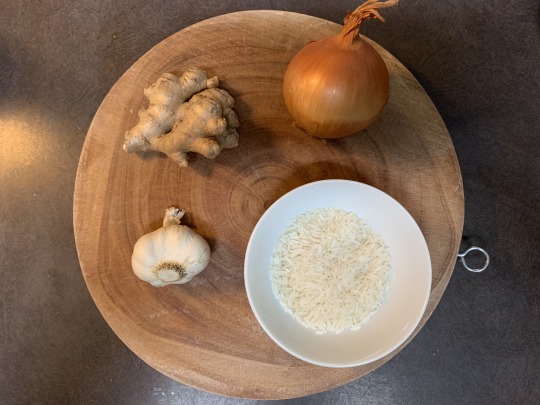
rice, ginger, onion, garlic
Obviously, we’re making a savory congee. Otherwise, if you’d like to make one that is sweet, omit the garlic and onion and maybe the ginger. Depends on the flavor profile you’re going for, but you could use it still if you’re going for something like a chai congee or even a pumpkin spice one. I haven’t tried those variations yet, but I just might have to with some coconut cream or something. BESIDES THE POINT….
For this recipe, I used a pressure cooker, but you can definitely make it on the stovetop! I’ve never made it that way before, and it takes longer, but it’s absolutely doable! Additionally, you can make congee with a rice maker alone. I won’t include those directions here because they aren’t tried and true, but they’re incredibly easy to find online.
I will also say, while you can substitute onion powder and garlic powder for the fresh onion and garlic, I do not recommend substituting ginger powder for the fresh ginger. You really cannot beat the flavor that it imparts on the whole thing. It is an absolute must when making the congee.
Here are some add-ins that I will be using for our breakfast with Yang!

As I mentioned before, this is a highly customizable meal. While I’m typically a “fresh ingredients” person, I really do think that the chicken bouillon is necessary in this recipe. It imparts an umami flavor that you didn’t know that you needed. It’s an easy ingredient to keep on hand, much more convenient than cans or cartons of more costly chicken broth or stock. However, if you’d prefer, you can definitely swap out the water and bouillon for chicken broth or stock.
Chinese doughnuts are also popular with congee or even by themselves! They are also mentioned at some point in Piofiore by their Chinese name, youtiao. You can try making them at home yourself, as there are many recipes online, but I was able to find them in the frozen foods aisle at the Asian market. It’s not one of the more common things that you can find in the frozen foods section; this past weekend was my first time ever seeing them frozen. You can also get them at Chinese and Vietnamese bakeries. When I was growing up, we used to cut them into 1-inch pieces and added them to the congee. But we also ate them on their own as well!

Also, if you will note in the screenshot of the meal earlier, the MC mentions “Chinese parsley.” Chinese parsley is also known as coriander or cilantro, so you would use that. Don’t go trying to hunt down Chinese parsley, because cilantro and coriander are the exact same thing. “A rose by any other name…” and all that.
The fried onions/shallots can be found in any Asian market and even some specialty stores, but if you can’t find it, you could definitely fry up some shallots or garlic to add as a mix-in. If I had to have only one mix-in, the shallots would be it.
My daughter loves quail eggs, so we added it to the soup. However, you could just as easily crack an egg in and mix it in or crack it on top for an easy effect. Eggs make a great addition to congee.
I also like to use rotisserie chicken to make this an even easier and quicker meal to make than to use raw chicken. I suggest saving the jelly-like goo to add to the soup as it imparts flavor as well as a silky mouthfeel to the soup. In case you did not know, that substance is gelatin. If you wanted to, you could also include the chicken carcass to extract more gelatin and chicken flavor, but I like to save them for other recipes.
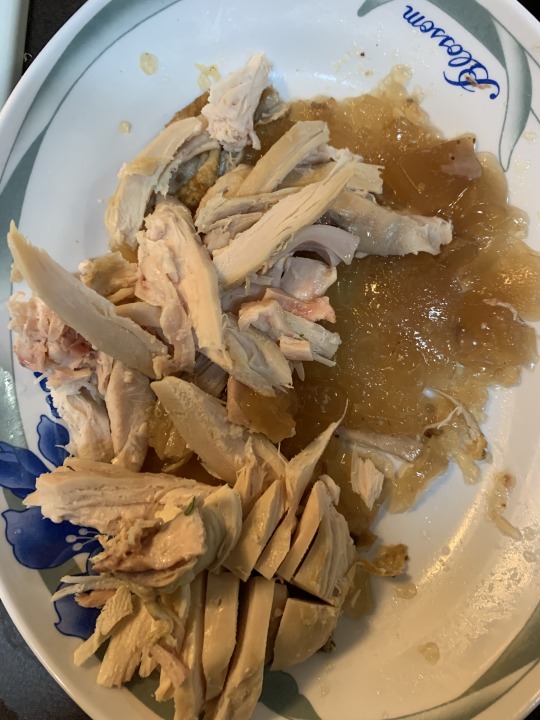
I know it looks kind of gross, but it’s essential to the recipe!
However, if you are making this vegetarian, you can omit any of the chicken, bouillon, and anything else meat-related. To give it umami flavor, you can instead use soy sauce as a seasoning when everything is cooked, and you're ready to eat. However, with all of the chicken seasoning, you won't need to add soy sauce because it will be so flavorful in the end.
The next thing I made for the breakfast is Scrambled Eggs with Garlic Chives. This is not an original recipe. I got it from The Woks of Life website. The recipe is hyperlinked, but following are pictures of the direction steps. This is one of my absolute favorite recipes. It's super easy to whip up, and it goes well with congee or simple rice with a little soy sauce.
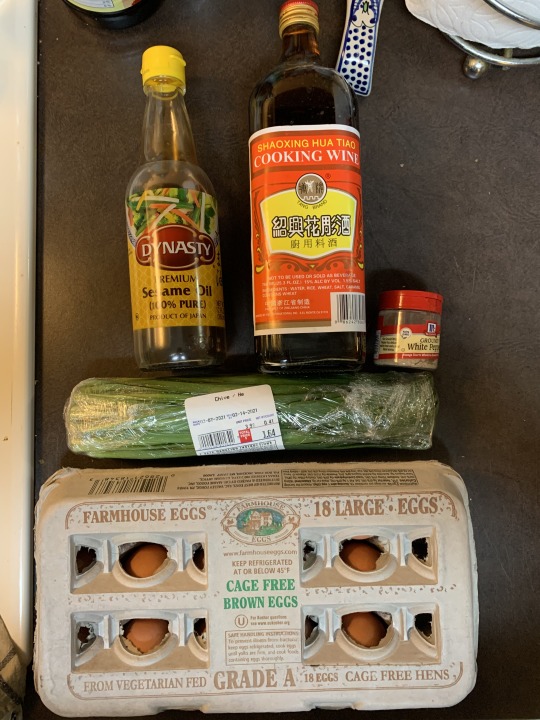
Garlic chives look very much like green onions, but they're much more mild in flavor and sauté very nicely. If you're going to use green onions instead, that's fine, but I would largely reduce the amount you use. It's an okay substitution, but if you're able to get the garlic chives, definitely get those.
Here's what they look like without the packaging:
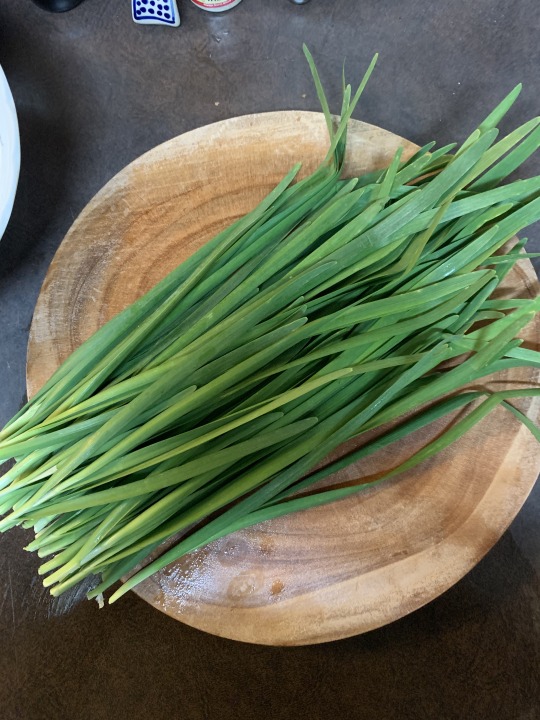
Kind of looks like grass, right? Sometimes, they'll have small blossom buds at the top that are totally edible too.
This is what it looks like to have the eggs and seasonings mixed with the small bubbles, as called for in the recipe:
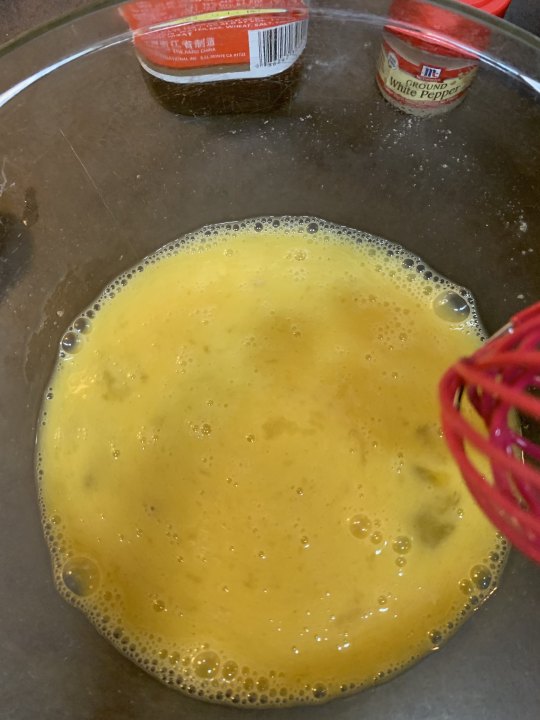
The water that you include in the mix helps with this. It probably took me about 30-45 seconds of rigorous mixing to get those bubbles.
This is the halfway point of sautéing the egg and garlic chive mixture:
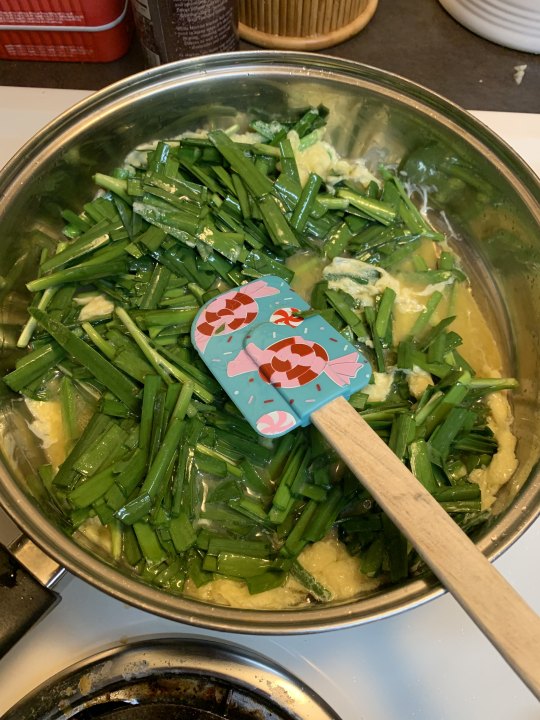
So you may notice here that the chives look shiny, and that's because the egg whites are clinging to them. Additionally, it looks like the chives aren't cooking. They will.
This is what your eggs should look like by the end of it:
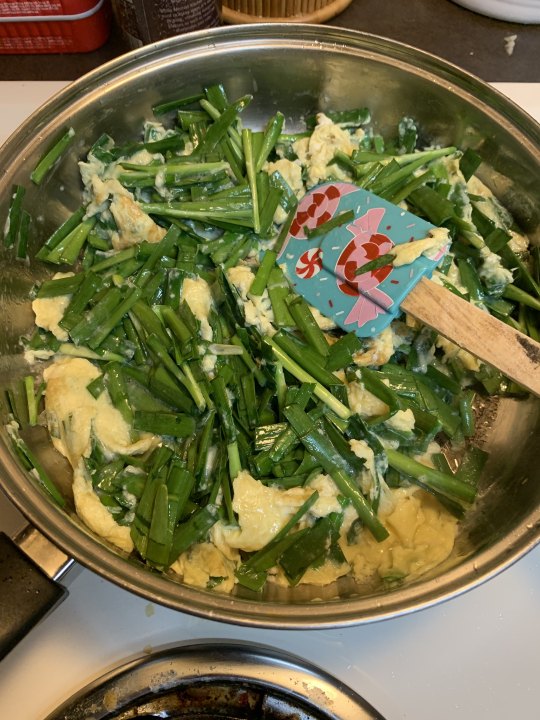
From here, it will take maybe only one more minute to cook the chives.
I rounded out the meal with pork baos, which are steamed buns filled with a sweet Chinese barbecue pork and these big ass apples that are often sold during holidays, particularly Lunar New Year, which was February 12th this year.
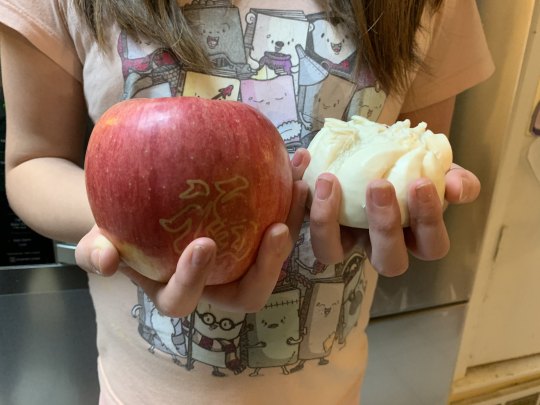
And now, for the congee recipe!
CHICKEN AND GINGER PRESSURE COOKER CONGEE
Ingredients: 1 cup jasmine rice, rinsed and drained (at least 3 times) 8 cups of water or chicken broth 1 1-inch piece of ginger, peeled 1 medium to large yellow onion, washed 4-5 cloves of garlic, minced 4 tbsp chicken bouillon (optional) fish sauce (optional, to taste) sugar (to taste) freshly ground black pepper (to taste)
Suggested add-ins cooked chicken cilantro, chopped green onions, chopped fried shallots soy sauce (if not using chicken bouillon) youtiao quail eggs poached eggs
Directions
1.) Put first five ingredients (and chicken bouillon, if using) in your pressure cooker. Make sure to seal the vent. Set the cooker to HIGH and on 30 minutes. In the meantime, prepare your add-ins.
2.) Once the pressure cooker timer goes off, allow for the pressure cooker to natural release. That means to leave it alone until the pressure is completely released. If you do not have the time to do a full natural release, set your timer to ten minutes, then open the vent to release the remaining steam.
3.) Remove and discard the onion and ginger. Stir the contents of the pressure cooker. If the soup looks too thick for you, add water until it is at a consistency you'd prefer. I usually add an extra 2 - 4 cups of water because I like my congee a little thinner. There is no right or wrong consistency. Go with your preference.
4.) Once the congee is to your preferred consistency, taste to see if you like the flavor. If it is not salty enough, add more bouillon or salt. Soy sauce is used as a finishing seasoning, not a flavoring while cooking. Add chicken and quail eggs, and let the soup heat on low to medium-low to bring the proteins to temperature, as well to heat up the soup if you added water.
5.) Make sure that your proteins are warmed and the congee is hot before serving. Add remaining suggested add-ins to your liking.
Be sure to round out your meal with some nice hot jasmine tea or sweetened soy milk!
Be sure to let me know if you tried the recipe!
After note: I realized that I have become everything that I hate about food blogging by this blog. So sorry for the long exposition lolol
#Piofiore#piofiore fated memories#yang#piofiore yang#Lao shu piofiore#recipe#otome#otome recipe#otome food
0 notes
Text
Daniel's Favorite Recipes of 2018
[Photographs: Vicky Wasik, unless otherwise noted]
This was a big year for me. At the end of 2017, my wife, Kate, and I had a baby, so 2018 was our wild walk through his first year as he grew from a little lump of flesh to a walking and talking(ish) mini human who loves to dance to music, give hugs, and eat literally everything we put in front of him—and we've put some ambitious food on his plate.* This life-changing new family member has also meant that my memory of the past year is something of a blur. What did I cook? What did I write?
* By my own personal standards, I think he's excelling in all the important areas.
This year has also been a big one for the Serious Eats culinary team. You likely (hopefully) never noticed this, but we'd been separated from our colleagues for nearly two years as our new test kitchen finished construction. We produced our recipes and cooking articles from all sorts of temporary spaces, including commercial kitchen rentals, AirBnB rentals, and even my apartment. Finally, though, the work was completed and we moved in (technically we moved in several months before the gas was turned on, using induction units as our only mode of "stovetop" cooking, but now even the gas flows, strong and hot). That gives us a lot to look forward to in 2019, our first year with a fully functioning test kitchen from day one. We've got a lot to cook for you in there!
Before we do, though, here are some of my favorite recipes from the last year. It took some sorting through our archives to jog my blurred memory, but I'm glad I did. We shared a lot of delicious stuff that's worth remembering.
This is one of my last recipes of 2018, and I am very proud of it. Duck à l'orange is one of those dishes that's been bastardized to the point where many renditions now bare little resemblance to the original, often featuring roasted duck doused in an overly sweet orangey glop. Instead of just copying the methods and ratios of most of the other recipes that are online now, I decided to go back to the beginning, making the sauce, classically known as sauce bigarade, with the bitter oranges that are meant to be used. Then I did my best to rejigger things to approximate that more complex, less sweet, flavor in my recipe for the sauce. Tart and aromatic, it's the perfect foil for fatty duck, and also a prime option for the holiday table.
Get the recipe for duck à l'orange or read about the process and testing »
When Sho approached me with the idea of doing a series of ramen recipes including homemade noodles and two different broths that harness the power of the pressure cooker, I got really excited. Homemade ramen is one of those things that just doesn't seem worth the effort, especially when you live near great ramen shops that can serve up a bowl in five minutes, then do the dishes for you. But add in the time savings of the pressure cooker, and the fact that you can first make this clear and savory shoyu broth, then a second creamy paitan broth using the spent ingredients from the first one, and that's a project I'm down for. The results are killer, and remarkably doable.
Get the recipe for chintan shoyu ramen or read about the process and testing »
Senior culinary editor Sasha Marx joined our team late this year, and he hit the ground running. He grew up in Rome, and we wasted no time asking him to share some of his expertise on that city's cuisine. One of the most memorable is his absolutely perfect take on pasta alla gricia—one of Rome's foundational pasta dishes, starring little more than cured pork jowl, cheese, and black pepper. His bowl of rigatoni is coated in a glistening, emulsified sheen of rendered fat and Pecorino Romano, all of it deeply infused into the pasta during a many-minute finishing step in the sauce. This here is how to cook pasta right.
Get the recipe for pasta alla gricia or read about the process and testing »
Coming up with a centerpiece-worthy vegetarian main course for the holidays is an extremely difficult task. Vegetables just don't lend themselves to impressively hulking roasts the way meat does. I'd been wracking my brain for weeks trying to think up something clever and not tired, and was about to give up. Then Sasha suggested stuffed pumpkins. Here's the thing—I know those words don't necessarily grab one's attention. Stuffed pumpkins? Yawn. But these are no joke. Loaded with a custardy savory bread pudding, heaps of melted cheese, sautéed mushrooms, kale, and more, his stuffed pumpkins can take on any slab of roast meat or poultry, delivering layers of flavor and texture in each bite. I would happily take one and leave the meat for everyone else. Or...maybe have both?
Get the recipe for stuffed roasted pumpkins or read about the process and testing »
I'm not a huge frosted cake fanatic, and Stella isn't a huge Italian buttercream fan (you can read why here), making this an unlikely selection on my list. But despite all the odds stacked against it, this one was one of my favorite recipes she made this year. There's just something about the flavor of that honey in the light, fluffy buttercream, especially with a healthy pop of salt, that just does it for me. There's a lot of cake I'll say "no thanks" to, but this one is a "yes, please," over and over, and over again.
Get the recipe for honey buttercream or read about the process and testing »
This is another one of those French classics I tackled this year, and I was surprised at the tweaks I found to make the recipe, I believe, better. First I introduced a dry-brining step, which makes it possible to both season the steak and get the peppercorns to adhere to it (if you put the salt on right before cooking, the pepper won't stick), leading many chefs to add the salt after the peppercorns—in which case the salt doesn't stick! I also decided to only encrust one side of each steak with the pepper, allowing the other side to sear and develop a good fond in the pan that otherwise wouldn't happen with a layer of pepper in the way. That omitted portion of pepper, meanwhile, doesn't get lost: I bloom it in hot fat to develop its flavors, then work it directly into the pan sauce. Result: best of all worlds.
Get the recipe for steak au poivre or read about the process and testing »
I devoted a considerable amount of time this year to digging deeper into the world of mortars and pestles, which I believe should be used way more frequently than they are in most home kitchens. One of the fun byproducts was this recipe for a lesser known Italian pesto sauce. Originating in Sicily, this one replaces the pine nuts with almonds, and adds tomato to the mix, for a fresher, fruitier summery sauce. Dare I say I like it more than classic pesto?
Get the recipe for pesto alla trapanese or read about the process and testing »
When Stella unveiled her cookie ice creams (no, not cookie dough ice creams) a couple years ago, we all went crazy for them. It didn't take long for us to start lobbying her for even more recipes featuring our own favorite cookies. The fact that oatmeal-raisin are at the top of my cookie list very possibly had nothing to do with Stella deciding to turn them into this outrageous scoop, but I'd like to think otherwise.
Get the recipe for oatmeal-raisin cookie ice cream or read about the process and testing »
Inspired by Popeye's but worlds beyond it in flavor (and I say that as a diehard Popeye's fanatic), this fried chicken recipe from Sohla belongs in everyone's rotation...unless you're a mutant who doesn't like fried chicken (okay, okay, or a vegetarian). The buttermilk-brined chicken is juicy, the crust is crispy and nubby, and it's drizzled in honey-butter, then finished with a dusting a fragrant ground spices and chilies. It's hard to top Popeye's, but the twists and turns here just might do it.
Get the recipe for fried chicken with honey and spice or read about the process and testing »
[Photograph: Liz Clayman]
As I near the end of my top picks list, I begin to see a trend emerging: I set my sights on a fair number of classic French dishes. I'm not unhappy about that. This exploration of bouillabaisse got me thinking all about fish—specifically, how to select ones that approximate what traditionally goes into the soup, given that we don't have access to most of the fish used in Marseille. Too many renditions of the dish in the United States have dodged this question, instead loading the soup up with lobster, scallops, clams, shrimp, and other fish that, while delicious, produce a broth that has very little in common with what bouillabaisse is all about.
Get the recipe for bouillabaisse or read about the process and testing »
I like mango lassi as much as, if not more than, the next person, but this salty rendition from Sohla is something I could drink morning, noon, and night. I'm not sure I'd ever tire of the savory combo of tangy yogurt and buttermilk with fresh mint and cilantro, fragrant spices, and a slow-burning hear of kashmiri chilies.
Get the recipe for salted mint lassi or read about the process and testing »
This post may contain links to Amazon or other partners; your purchases via these links can benefit Serious Eats. Read more about our affiliate linking policy.
Source: https://www.seriouseats.com/2018/12/daniels-favorite-recipes-of-2018.html

0 notes